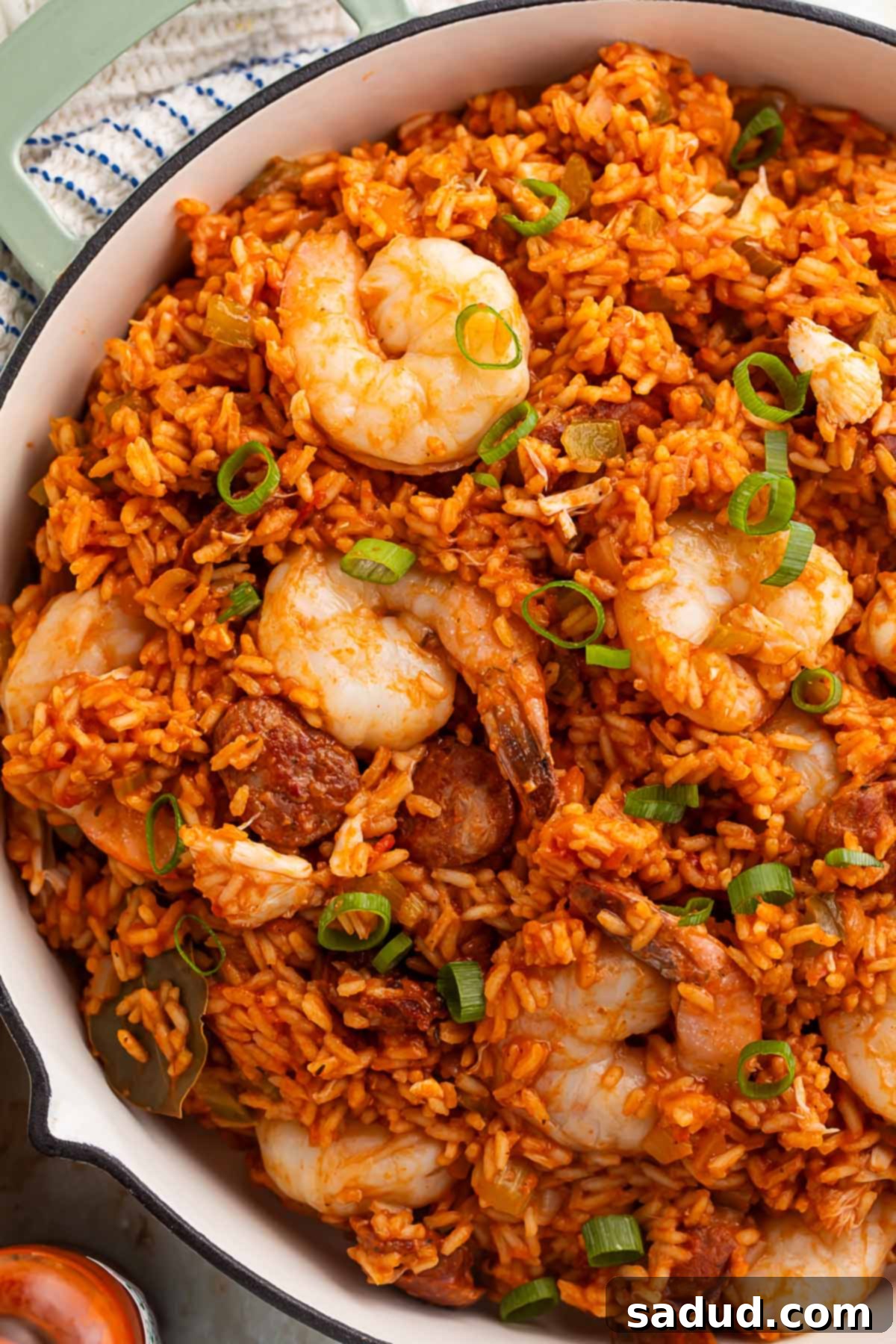Authentic Louisiana Seafood Jambalaya: A Hearty Taste of the Big Easy
Embark on a culinary journey to the heart of Louisiana with this incredible seafood jambalaya recipe. Bursting with tender, flavorful rice, succulent shellfish, and savory Andouille sausage, this dish is more than just a meal—it’s a celebration of Southern comfort and vibrant Creole flavors. Imagine a steaming bowl, rich with spices and textures, bringing the warmth and festive spirit of the Big Easy right to your dinner table. Whether you’re a seasoned chef or a home cook looking for an exciting new dish, this hearty, satisfying jambalaya is guaranteed to be a hit, making every bite an unforgettable experience.
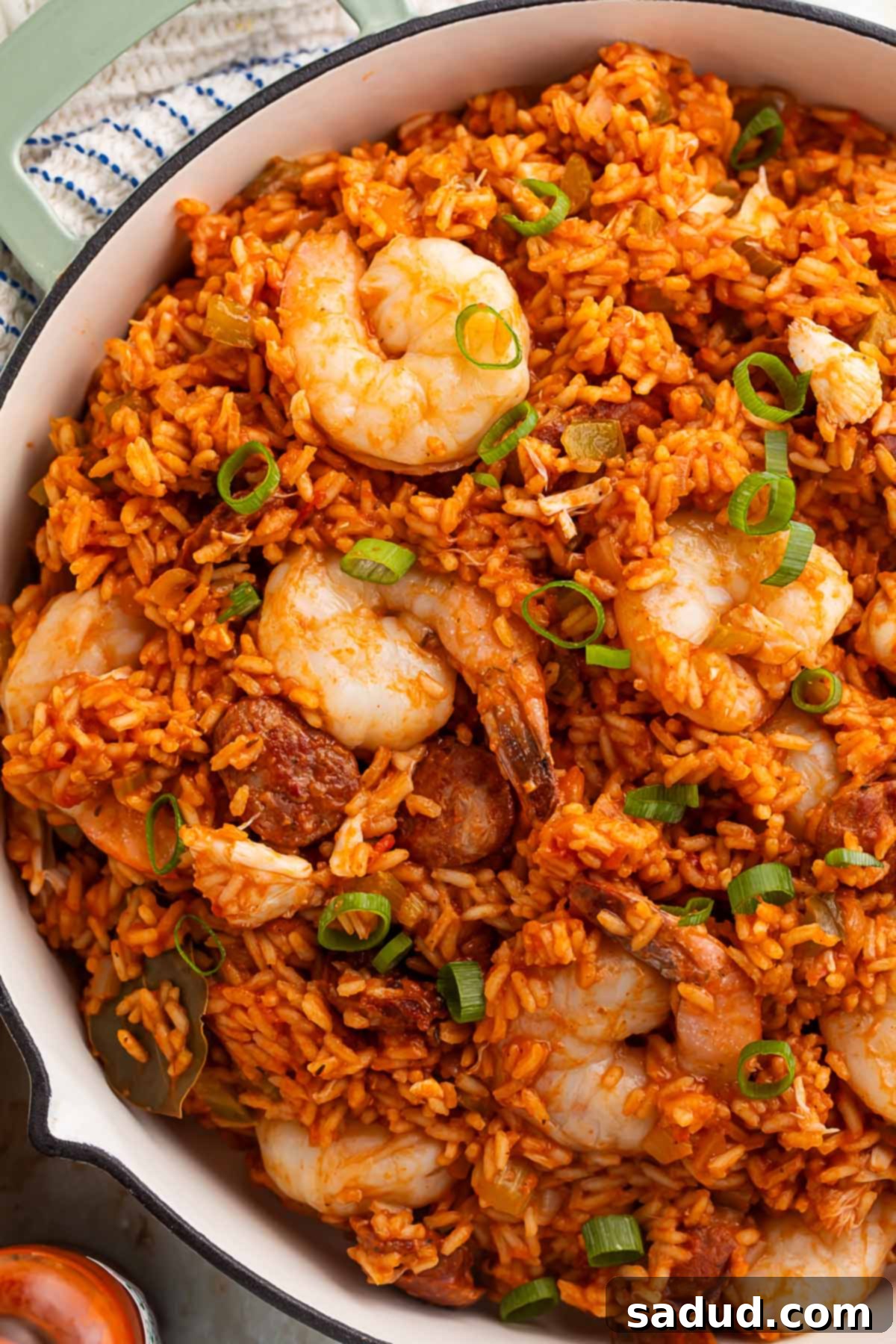
Why You’ll Adore This Seafood Jambalaya
This Louisiana-style seafood jambalaya isn’t just a recipe; it’s an experience. Here’s why this dish will quickly become a cherished favorite in your kitchen:
- An Unforgettable Medley of Textures and Flavors: You simply won’t find a more satisfying combination! Each spoonful offers a delightful interplay of textures and tastes. Imagine perfectly browned Andouille sausage, offering a smoky, spicy kick. Then, the juicy, plump shrimp and delicate, succulent lump crab meat melt in your mouth, contributing a fresh taste of the ocean. All of these incredible elements are bound together by fluffy, seasoned long-grain rice, simmered to perfection in a rich, aromatic stock. Every single bite is a revelation, a complex dance of savory, subtly spicy, and deeply comforting flavors that build upon each other. It’s truly a symphony for your taste buds!
- The Aromatic Magic of Creole Seasoning: This recipe harnesses the authentic essence of Creole cuisine with a generous hand of Creole seasoning. This blend masterfully combines the earthy notes of paprika, the pungency of onion powder, the herby freshness of oregano, dried basil, and thyme, all perfectly balanced with salt and pepper. Unlike its spicier cousin, Cajun seasoning, Creole seasoning tends to be on the milder side, focusing more on a layered aromatic profile rather than overwhelming heat. This makes it perfect for those who appreciate robust flavor without excessive spiciness. However, the beauty of this recipe is its adaptability: you can easily adjust the amount of Creole seasoning to match your personal preference for intensity, ensuring a customized culinary delight every time.
Essential Chef’s Tips for a Perfect Jambalaya
Crafting an exceptional seafood jambalaya involves a few key techniques that elevate the dish from good to truly extraordinary. Pay attention to these chef-approved tips for maximizing flavor and ensuring a fantastic result:
- Slicing Andouille Sausage “On the Bias”: While it might seem like a minor detail, how you slice your Andouille sausage significantly impacts its flavor and texture in the final dish. Instead of slicing perpendicular (a 90° angle) to the sausage, cut it at a 45° angle, or “on the bias.” This simple trick creates a larger surface area on each sausage piece. A larger surface area means more contact with the hot pan, leading to a deeper, more consistent browning and caramelization. This browning process develops a richer, more complex savory flavor in the sausage, which then contributes profoundly to the overall depth of the jambalaya. It’s a small effort with a big flavor payoff!
- Shrimp Tails: A Matter of Personal Preference: When preparing your shrimp, you have the option to leave the tails on or remove them. This choice is purely aesthetic and experiential. Some people prefer to leave the tails on for presentation, as they can make the shrimp look more appealing and visually highlight the seafood element in the dish. However, from a practical eating standpoint, leaving the tails on means you’ll need to remove them while you’re actively enjoying your bowl of jambalaya, which can interrupt the flow of your meal. Personally, I find it much more enjoyable to have fully peeled and deveined shrimp, allowing for seamless, delicious bites without any extra fuss. Consider your guests and your own dining preference when making this decision.
- Balancing Salt with Creole Seasoning: Most commercially available Creole seasoning blends already contain salt. Because of this, it is absolutely crucial to taste your jambalaya before adding any additional salt. You might discover that the seasoning blend provides all the saltiness needed, especially when combined with chicken or seafood stock, which also contribute sodium. Adding salt prematurely can lead to an overly salty dish that is difficult to correct. Always taste, then adjust gradually. This approach ensures your jambalaya achieves the perfect savory balance without being overpowering.
- The Power of the “Holy Trinity”: The foundation of any authentic Louisiana dish, including jambalaya, is the “Holy Trinity” – a harmonious blend of chopped onion, celery, and green bell pepper. Take your time sautéing these vegetables. Allowing them to soften and become translucent, especially the onions, builds a deep, sweet, and aromatic base for the entire dish. Don’t rush this step, as it’s where much of the underlying flavor of your jambalaya will originate.
- Choosing the Right Rice: For jambalaya, long-grain white rice is traditionally preferred. It absorbs flavors beautifully and cooks up into separate, fluffy grains rather than becoming sticky or clumpy, which is essential for the characteristic texture of jambalaya. Avoid using short-grain or medium-grain rice, which can release too much starch and result in a mushy consistency.
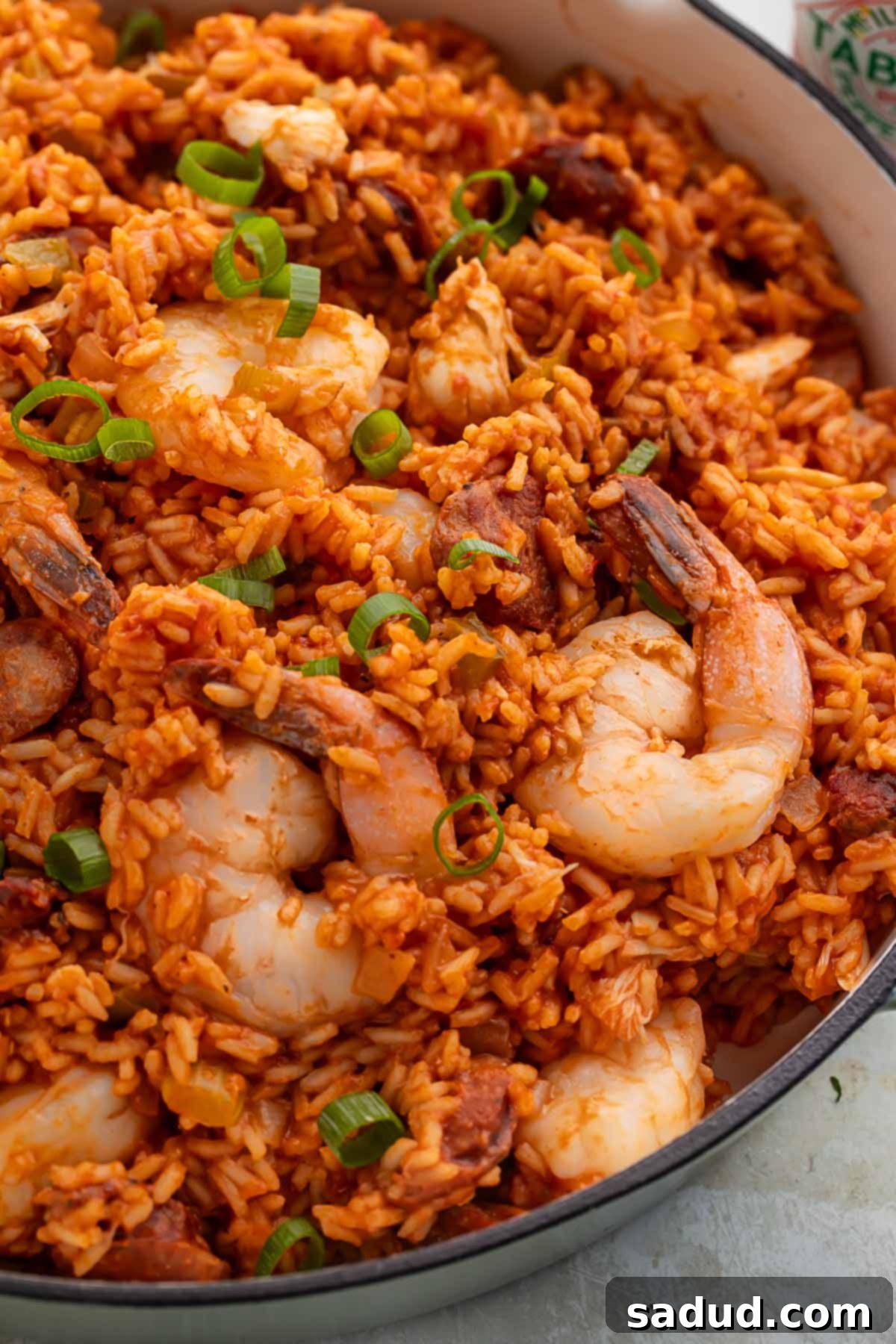
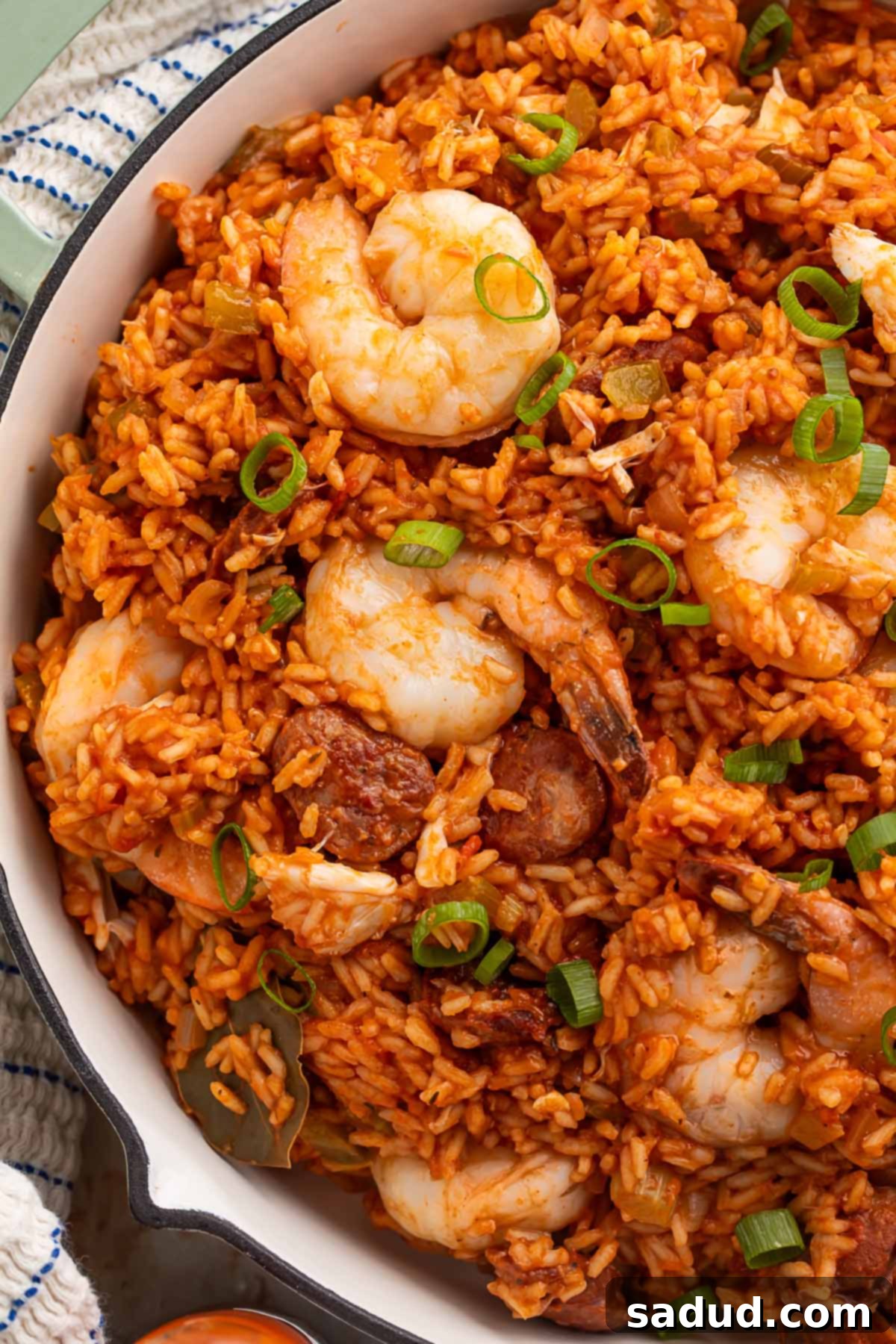

The Rich History of Jambalaya
Jambalaya is more than just a dish; it’s a culinary emblem of Louisiana, a reflection of its diverse cultural heritage. Originating in the Spanish quarters of New Orleans, it was an attempt to make paella using locally available ingredients. Tomatoes, which were readily available, replaced saffron, and various meats and seafood became the stars of the dish. There are two main variations: Creole (or “red”) jambalaya, which includes tomatoes and is often associated with New Orleans, and Cajun jambalaya, typically made without tomatoes and more prevalent in rural Louisiana. This recipe leans into the vibrant, tomato-rich Creole style, packed with flavors that tell a story of colonial influences and regional adaptations. Every spoonful is a taste of history, a tradition passed down through generations of Southern cooking.
Serving Suggestions & Pairings
While this seafood jambalaya is a complete and incredibly satisfying meal on its own, a few simple additions can elevate the dining experience:
- Crusty French Bread: Perfect for soaking up the rich, flavorful juices at the bottom of the bowl.
- A Simple Green Salad: A light, crisp salad with a vinaigrette dressing provides a refreshing contrast to the richness of the jambalaya.
- Hot Sauce: For those who love an extra kick, a dash of your favorite Louisiana hot sauce can personalize the spice level.
- Cornbread: Another Southern classic that pairs wonderfully, offering a sweet and savory balance.
- Beverage Pairings: A crisp, dry white wine or a cold lager complements the seafood beautifully. For non-alcoholic options, iced tea or sparkling water with lemon are great choices.
Storage and Reheating Tips
Jambalaya often tastes even better the next day as the flavors have more time to meld. If you have leftovers, store them properly to enjoy later:
- Storage: Allow the jambalaya to cool completely, then transfer it to an airtight container. It can be stored in the refrigerator for up to 3-4 days.
- Freezing: For longer storage, jambalaya freezes beautifully. Portion it into freezer-safe containers or heavy-duty freezer bags and freeze for up to 2-3 months. Thaw overnight in the refrigerator before reheating.
- Reheating: For best results, reheat individual portions on the stovetop over medium-low heat, adding a splash of chicken or seafood stock or water to prevent it from drying out. Stir frequently until heated through. You can also reheat in the microwave, stirring halfway through, but be careful not to overcook the seafood.
More Incredible Seafood Recipes to Explore
- Seafood Chili
- Lobster Mashed Potatoes
- Shrimp Parmesan
- New Orleans BBQ Shrimp Po-Boy
- Instant Pot Crab Legs
- Oyster Brie Soup (from Disney World’s Hollywood Brown Derby)
- Shrimp Remoulade
- Tuna Tetrazzini
- Lobster Fried Rice
- Shrimp and Corn Soup
- Cajun Shrimp
- Lobster Mac and Cheese
- Quick & Easy Blackened Shrimp
- Pan-Seared Salmon in a Creamy Red Pepper Parmesan Sauce
- Keto Gumbo
- Seafood Baked Potato
If you loved this recipe as much as we did, don’t forget to leave us a review below. ★ Follow Easy Healthy Recipes on Pinterest, Facebook, and Instagram, too!
For more delicious recipes, visit our sister sites, 40 Aprons and Easy Cheap Recipes.
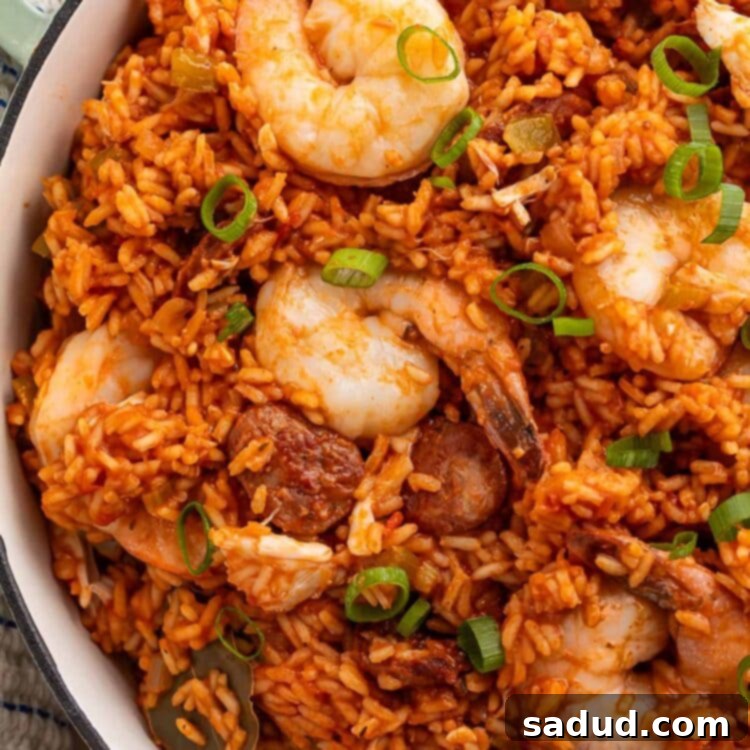
Seafood Jambalaya
 Cheryl Malik
Cheryl Malik
Print
SaveSaved!
Ingredients
- 1 pound andouille sausage or smoked sausage, sliced on 45° diagonals for maximum browning
- 2 tablespoons butter or chicken fat, or lard for richer flavor
- 2 tablespoons minced garlic approximately 4 large cloves, plus more to taste for garlic lovers
- 1 ½ cups chopped white onion approximately 1 large onion, part of the ‘holy trinity’
- 1 cup chopped green bell pepper approximately 1 large bell pepper, part of the ‘holy trinity’
- 1 cup chopped celery approximately 4 stalks, completing the ‘holy trinity’
- 2 tablespoons tomato paste
- 2 cups chicken stock or seafood stock for a deeper oceanic flavor
- 1 28-ounce can diced tomatoes
- 2-3 tablespoons Creole seasoning more or less to taste, adjust for spice preference
- 2 bay leaves
- salt optional, to taste after seasoning, as Creole blends often contain salt
- 6 cups chicken stock or seafood stock to ensure rice is perfectly cooked and flavorful
- 4 cups long-grain white rice uncooked, rinsed until water runs clear for best texture
- 1 pound shrimp large (31-40 per pound) or extra-large (26-30 per pound); peeled, deveined, tails on or off
- 8 ounces jumbo lump crab meat drained, for tender, sweet seafood notes
Equipment
-
Large skillet
-
large dutch oven or similar large, heavy-bottomed pot, essential for even cooking
-
large wooden spoon for stirring and scraping the bottom
Instructions
-
Begin by placing a large skillet on your stovetop and heating it over medium-high heat. Add the 1 pound of Andouille sausage (or smoked sausage, sliced on 45° diagonals as per chef’s tip) to the hot skillet. Cook the sausage, flipping the slices frequently, until they are beautifully browned and slightly crispy on both sides. This step is crucial for rendering some of the fat and developing deep, smoky flavors.
-
Once the sausage has achieved a rich brown color on both sides, carefully drain any excess liquid or rendered fat from the skillet. Set the browned sausage aside; it will be added back into the jambalaya later.
-
While the sausage is browning, prepare your main cooking vessel. Place a large Dutch oven or a similarly large, heavy-bottomed pot on the stovetop over medium-high heat. Allow the pot to warm up for a couple of minutes, then add the 2 tablespoons of butter (or chicken fat/lard) and let it melt completely, coating the bottom of the pot.
-
As soon as the butter has melted and is shimmering, add the 2 tablespoons of minced garlic to the pot. Sauté the garlic, stirring constantly to prevent burning, for about 30 to 60 seconds, or until it becomes wonderfully fragrant. Be careful not to let it brown too much.
-
Immediately after the garlic becomes fragrant, add the ‘holy trinity’ of vegetables: 1 ½ cups of chopped white onion, 1 cup of chopped green bell pepper, and 1 cup of chopped celery to the pot. Stir well to combine all ingredients, then continue to sauté the trinity, stirring frequently, for approximately 5 minutes. Cook until the onions become translucent and the vegetables have softened slightly.
-
Once the onions are translucent and the trinity is tender, reduce the heat under the pot to medium. Add the 2 tablespoons of tomato paste to the pot and stir it in thoroughly with the vegetables. Cook the tomato paste for 3 to 5 minutes, stirring constantly. This step allows the tomato paste to deepen in color and caramelize, enriching the overall flavor profile of the jambalaya. Ensure it doesn’t burn by keeping it moving.
-
When the trinity vegetables have completely softened and the tomato paste has achieved a rich, deep reddish-brown color, pour in 2 cups of chicken stock (or seafood stock). Stir vigorously to incorporate the stock and deglaze the pot. Use your wooden spoon to scrape the bottom of the pot, loosening any browned bits of food that may have stuck. These bits are packed with flavor!
-
Continue stirring the mixture until the tomato paste and stock are fully combined, creating a smooth and somewhat thickened base. This forms the flavorful ‘gravy’ for your jambalaya.
-
Next, add the 1 28-ounce can of diced tomatoes (undrained), 2-3 tablespoons of Creole seasoning, and 2 bay leaves to the pot. Stir all the ingredients together thoroughly to ensure they are well incorporated. Then, reduce the heat under the pot to medium-low.
-
Allow this aromatic mixture to simmer gently over medium-low heat for 10 minutes, stirring occasionally. This simmering time allows the flavors to meld beautifully and the tomatoes to break down slightly, creating a more cohesive sauce.
-
After 10 minutes of simmering, add the remaining 6 cups of chicken stock and the 4 cups of uncooked long-grain white rice to the pot. Stir everything together one last time to ensure the rice is evenly distributed and submerged in the liquid.
-
Bring the mixture to a gentle boil, then immediately reduce the heat to low, cover the pot tightly, and let it simmer for 20 to 25 minutes. During this time, resist the urge to lift the lid or stir. The rice needs to cook undisturbed, absorbing all the flavorful liquid until it is tender and all the moisture has been absorbed.
-
Once the rice is fully cooked and the liquid is absorbed, taste a small portion of the rice. This is the moment to adjust the seasoning: add more Creole seasoning if you desire more flavor, or add salt only if necessary, remembering that Creole seasoning often contains salt.
-
Reduce the heat under the pot to its lowest setting. Gently fold in the 1 pound of shrimp, the 8 ounces of jumbo lump crab meat, and the previously browned Andouille sausage. Stir gently to evenly distribute the seafood and sausage throughout the rice.
-
Continue to simmer the mixture on low heat, stirring occasionally and gently, for approximately 10 minutes. Cook until the shrimp turns opaque pink and is cooked through, and the jambalaya has thickened to its desired consistency. Be careful not to overcook the shrimp and crab, as they can become tough.
-
Once thickened, give the jambalaya a final stir to thoroughly incorporate all the delicious ingredients. As you stir, carefully locate and remove the bay leaves, discarding them. Portion the piping hot jambalaya into serving bowls and serve immediately. This dish is fantastic on its own, but it pairs wonderfully with warm, crusty French bread if desired, perfect for scooping up every last bit of flavor!
Notes
- Sausage: To maximize browning and flavor, slice your andouille or smoked sausage “on the bias.” This means cutting at approximately 45° angles on each end of the sausage pieces, rather than making blunt vertical cuts. This technique increases the surface area exposed to heat, resulting in a more delicious caramelization.
- Garlic: I personally enjoy a robust garlic flavor in my jambalaya. I recommend using anywhere from 3 to 6 large cloves, finely minced. Feel free to adjust this quantity to your personal preference – use as much (or as little) as you like!
- Creole Seasoning: Just like with the garlic, the amount of Creole seasoning is a matter of personal taste. I encourage using a generous amount to really capture the authentic Louisiana flavor, but you can always add more or less to suit your palate. Remember, some blends are spicier than others.
- Salt: Always remember that many Creole seasoning blends already contain a significant amount of salt. Therefore, it is crucial to taste your jambalaya thoroughly before adding any extra salt. You may find that the seasoning, along with the stock, provides all the necessary sodium.
Nutrition Information
Number of total servings shown is approximate. Actual number of servings will depend on your preferred portion sizes.
Nutritional values shown are general guidelines and reflect information for 1 serving using the ingredients listed, not including any optional ingredients. Actual macros may vary slightly depending on specific brands and types of ingredients used.
To determine the weight of one serving, prepare the recipe as instructed. Weigh the finished recipe, then divide the weight of the finished recipe (not including the weight of the container the food is in) by the desired number of servings. Result will be the weight of one serving.
